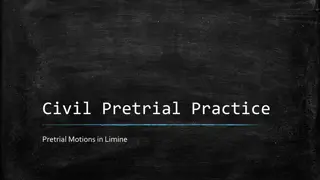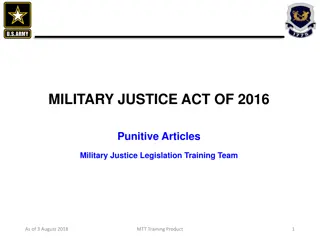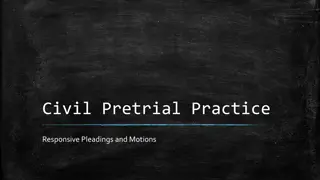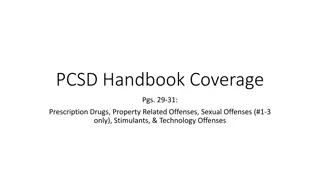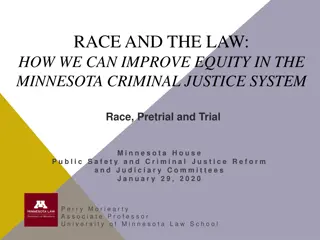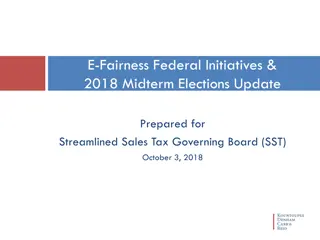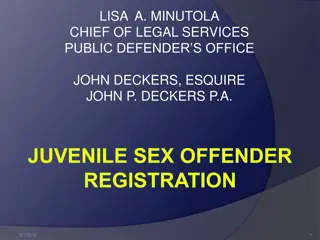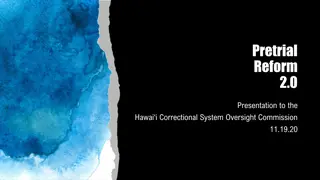Guide to Detainable Offenses under the Pretrial Fairness Act
The Pretrial Fairness Act allows for pretrial release for all persons charged with offenses before conviction, except in cases of detainable offenses where dangerousness or willful flight is involved. The state must prove by clear and convincing evidence that the defendant poses a real and present threat to safety. Considerations include the nature and circumstances of the offense, the defendant's history, and characteristics. Factors like prior criminal history or violent behavior are taken into account. Understanding detainable offenses is crucial for ensuring fair pretrial procedures.
Download Presentation

Please find below an Image/Link to download the presentation.
The content on the website is provided AS IS for your information and personal use only. It may not be sold, licensed, or shared on other websites without obtaining consent from the author. Download presentation by click this link. If you encounter any issues during the download, it is possible that the publisher has removed the file from their server.
E N D
Presentation Transcript
DETAINABLE OFFENSES under the Pretrial Fairness Act Hon. Debra Schafer 17thJudicial Circuit - Winnebago County October 27, 2022 This is not an official resource of the Illinois Supreme Court
Pretrial Release 725 ILCS 5/110-4 All persons charged with an offense shall be eligible for pretrial release before conviction. Pretrial release may only be denied when a person is charged with an offense listed in 110-6.1 or when the defendant has a high likelihood of willful flight and after the court has held a hearing under 110-6.1.
What qualifies as a detainable offense? 725 ILCS 5/110-6.1(a): Qualifying offense categories: Dangerousness (AKA threat of safety or safety ) Standard (110-6.1(a)(1-6)); AND Willful Flight Standard (110-6.1(a)(7))
Standard of proof for dangerousness standard 725 ILCS 5/110-6.1(e) State must show by clear and convincing evidence that: The proof is evident or the presumption great that the defendant has committed a detainable offense; AND The defendant poses a real and present threat to the physical safety of any person(s) OR in the case of a non-probationable forcible felony, to the community at large; AND No condition or combination of conditions can mitigate the real and present threat to any person(s) or to the community, if applicable.
Dangerousness Considerations 725 ILCS 5/110-6.1(e)(2) Whether a defendant poses a real and present threat to the safety of a specific, identifiable person, the court s considerations may include, but is not limited to, a forcible felony, the obstruction of justice, intimidation, injury, or abuse as defined in the IL Domestic Violence Act of 1986 (defined below). "Abuse" means physical abuse, harassment, intimidation of a dependent, interference with personal liberty or willful deprivation but does not include reasonable direction of a minor child by a parent or person in loco parentis. 750 ILCS 60/103(1)
Factors in considering dangerousness 725 ILCS 5/110-6.1(g) Considerations include, but not limited to, the following: Nature & circumstances of offense (Violent? Sex? Weapon?) History & characteristics of defendant May consider defendant s prior criminal or psychological history of violent, abusive or assaultive behavior, or a lack of such history. May consider evidence from any juvenile, family, quasi-criminal and civil proceedings. The identity of the person(s) at risk if defendant released Statements by defendant and surrounding circumstances Defendant s age and physical condition and victim/complaining witness age and physical condition Any history of weapon possession or access to weapons Whether defendant on state or federal probation, MSR, or on release pending trial, sentencing, appeal, etc. Anything else with reasonable bearing on propensity for violent, assaultive or abusive behavior, or a lack of it
Detainable offenses under dangerousness standard 110-6.1(a)(1) - Non-probationable Forcible Felonies 110-6.1(a)(2) - Stalking/Aggravated Stalking 110-6.1(a)(3) Victim = family/household member AND deft is subject to OP at the time of the arrest OR previously convicted of VOP or a violent offense against a family/household member 110-6.1(a)(4) Domestic Battery/Aggravated Domestic Battery 110-6.1(a)(5) Sex offenses 110-6.1(a)(6) certain Gun and Human Trafficking offenses
Definition of forcible felony 720 ILCS 5/2-8 Treason, first degree murder, second degree murder, predatory criminal sexual assault of a child, aggravated criminal sexual assault, criminal sexual assault, robbery, burglary, residential burglary, aggravated arson, arson, aggravated kidnaping, kidnaping, aggravated battery resulting in GBH or permanent disability or disfigurement and any other felony which involves the use or threat of physical force or violence against any individual.
Non-probationable forcible felonies 725 ILCS 5/110-6.1(a)(1) Must be both non-probationable AND a forcible felony This includes many Class X felonies like aggravated battery with a firearm, armed robbery, predatory criminal sexual assault, and aggravated criminal sexual assault.
Non-probationable forcible felonies 725 ILCS 5/110-6.1(a)(1) There are lower class felonies that also qualify for detention, for example: Residential burglary - Class 1 Aggravated battery to senior citizen (causing GBH) Class 2 Criminal Sexual Assault Class 1
Common probationable forcible felonies Examples of common forcible felonies that are NOT detainable under the dangerousness standard because they ARE probationable and are NOT one of the enumerated offenses under 110-6.1: Aggravated Battery involving GBH or permanent injury or disfigurement Robbery Burglary Arson
Non-enumerated forcible felonies The definition of forcible felonies is flexible and includes other offenses, depending on the facts based on the residual clause language: any other felony which involves the use or threat of physical force or violence against any individual. If the offense is not an enumerated forcible felony, the burden is on the state to present evidence at the detention hearing in support of their theory that a particular offense is a forcible felony.
Non-probationable forcible felonies 725 ILCS 5/110-6.1(a)(1) A judge can order detention only if: The defendant poses a specific, real and present threat to any person or the community; AND No condition or set of conditions can mitigate the real and present threat to any person(s). This is the only provision under the dangerousness standard in which a judge can consider a threat to the community at large.
Stalking & Aggravated Stalking 725 ILCS 5/110-6.1(a)(2) A judge can order detention only if: The defendant poses a real and present threat to the physical safety of the victim; AND Denial of release is necessary to prevent fulfillment of the threat upon which the charged is based; AND No condition or set of conditions can mitigate the real and present threat to the physical safety of the victim.
Offenses against family or household members 725 ILCS 5/110-6.1(a)(3) A judge can order detention only if: The victim is a family or household member; AND The defendant is subject to an OP at the time of arrest; OR The defendant had previously been convicted of VOP or a violent offense against a family or household member; AND The defendant poses a real and present threat to the physical safety of any person or persons.
Implications of 110-6.1(a)(3) First, the obvious: Someone charged with VOP against a family or household member is detainable. But under this section, an otherwise non-detainable offense against a family or household member may become detainable for a particular defendant because of his or her prior criminal history. For example, a CDTP or Unlawful Restraint or CTR to a family or household member would become detainable if the defendant has a prior VOP or Agg Batt or other violent offense conviction involving a family or household member.
Family or household member defined 750 ILCS 60/103(6) "Family or household members" include spouses, former spouses, parents, children, stepchildren and other persons related by blood or by present or prior marriage, persons who share or formerly shared a common dwelling, persons who have or allegedly have a child in common, persons who share or allegedly share a blood relationship through a child, persons who have or have had a dating or engagement relationship, persons with disabilities and their personal assistants, and caregivers as defined in Section 12-4.4a of the Criminal Code of 2012. For purposes of this paragraph, neither a casual acquaintanceship nor ordinary fraternization between 2 individuals in business or social contexts shall be deemed to constitute a dating relationship. In the case of a high-risk adult with disabilities, "family or household members" includes any person who has the responsibility for a high-risk adult as a result of a family relationship or who has assumed responsibility for all or a portion of the care of a high-risk adult with disabilities voluntarily, or by express or implied contract, or by court order.
VOPs 725 ILCS 5/110-6.1(a)(3) Violations of orders of protection under this section means violations of domestic violence orders of protection (both civil and criminal), NOT stalking/no contact orders or civil no contact orders.
Domestic Battery & Agg Dom Batt 725 ILCS 5/110-6.1(a)(4) A judge can order detention only if: The defendant poses a real and present threat to the physical safety of any person or persons; AND No condition or combination of conditions can mitigate the real and present threat to the physical safety of any person(s).
Sex offenses 725 ILCS 5/110-6.1(a)(5) A judge can order detention only if: The defendant poses a real and present threat to the physical safety of any person or persons; AND No condition or combination of conditions can mitigate the threat. Includes every sex offense listed in Article 11 except public indecency, adultery, fornication and bigamy.
Enumerated Gun and Human Trafficking Offenses 725 ILCS 5/110-6.1(a)(6) List of specifically enumerated offenses, but generally they are all gun- or human trafficking-related including, but not limited to: Agg discharge of a firearm Reckless discharge of a firearm Armed habitual criminal Unlawful use/possession of a weapon by a felon Involuntary servitude
Enumerated Gun and Human Trafficking Offenses 725 ILCS 5/110-6.1(a)(6) Includes only non-probationable versions of: Aggravated unlawful use/possession of a weapon (720 ILCS 5/24-1.6) Aggravated possession of a stolen firearm (720 ILCS 5/24-3.9)
Enumerated Gun & Human Trafficking Offenses 725 ILCS 5/110-6.1(a)(6) A judge can order detention only if: The defendant poses a real and present threat to the physical safety of any specifically identifiable person or persons; AND No condition or combination of conditions can mitigate the real and present threat to the physical safety of any specifically identifiable person(s).
Willful Flight Standard 725 ILCS 5/110-6.1(a)(7) Judge can order detention of a defendant charged with any felony listed in (a)(1)-(a)(5) OR any Class 3 or greater felony who has a high likelihood of willful flight to avoid prosecution. Any felony, including Class 4s, listed in (a)(1)-(a)(5), but NOT misdemeanors (a)(1)-(a)(5), NOT (a)(6) certain gun and human trafficking offenses This means willful flight cannot be a basis to detain a defendant charged with misdemeanor Dom Batt or VOP (because not felonies) or for reckless discharge of a firearm or Agg UUW (because they are Class 4s covered by (a)(6), not 1-5)
Willful Flight defined 725 ILCS 5/110-1(e) Willful flight means planning or attempting to intentionally evade prosecution by concealing oneself. Simple past non-appearance in court alone is not evidence of future intent to evade prosecution.
Standard of Proof for Willful Flight 725 ILCS 5/110-6.1(e) State must show by clear and convincing evidence that: The proof is evident or the presumption great that the defendant has committed a detainable offense; AND No condition or combination of conditions can mitigate the risk of defendant s willful flight.




